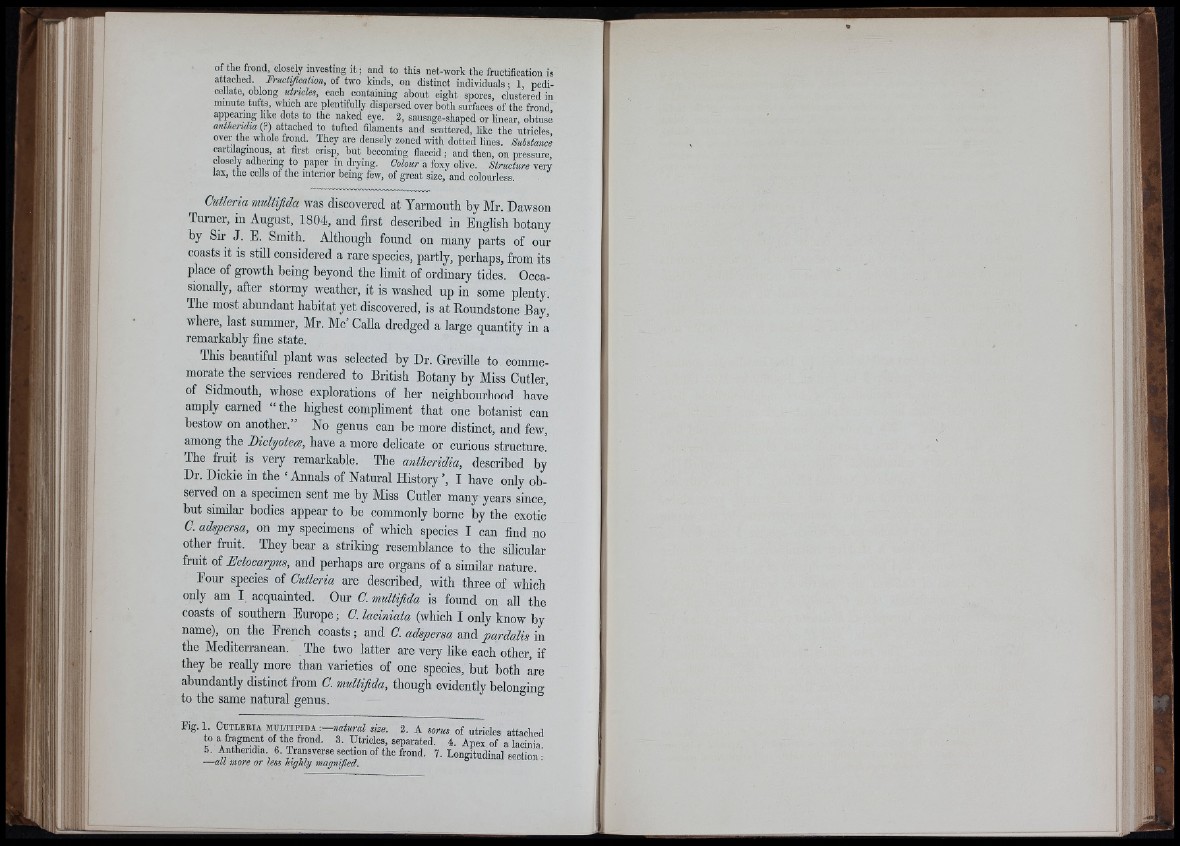
of the frond, closely investing i t; and to this net-work the fructification is
attached. Fructification, of two kinds, on distinct individuals • 1 pedicellate.
oblong utricles, each containing about eight snores, clustered in
mmute tufts, which are plentifully dispersed over both surfaces of the frond
appearing like dots to the naked eye. 2, sausage-shaped or linear, obtusé
« » am i/ia ?) attached to tufted filaments and scattered, like the utricles,
over the whole frond. They are densely zoned with dotted lines. Substance
cartilaginous, at first crisp, but becoming flaccid; and then, on pressme,
closely adhering to paper in drying. Colour a foxy olive. Structure very
lax. the cells of the interior being few, of great size, and colourless.
Cutleria multifida was discovered at Yarmouth by Mr. Dawson
Purner, in August, 1804, and first described in English botany
by Sir J. E. Smith. Although found on many parts of our
coasts it is still considered a rare species, partly, perhaps, from its
place of growth being beyond the limit of ordinary tides. Occasionally,
after stormy weather, it is washed up in some plenty.
The most abundant habitat yet discovered, is at Roundstone Bay,
where, last summer, Mr. Me’ Calla dredged a large quantity in á remarkably fine state.
Phis beautiful plant was selected by Dr. Greville to commemorate
the services rendered to British Botany by Miss Cutler,
of Sidmouth, whose explorations of her neighbourhood have
amply earned “ the highest compliment that one botanist can
bestow on another.” No genus can be more distinct, and few,
among the Bictyotem, have a more delicate or curious structure’
The fruit is very remarkable. The antheridia, described by
Dr. Dickie in the ‘ Annals of Natural History ’, I have only observed
on a specimen sent me by Miss Cutler many years since,
but similar bodies appear to he commonly home by the exotic
C. adspersa, on my specimens of which species I can find no
other frmt. They bear a striking resemblance to the silicular
fruit of Bctocarpus, and perhaps are organs of a similar nature.
Four species of Cutleria are described, with tliree of which
only am I acquainted. Our C. multifida is found on all the
coasts of southern Europe; C. laciniata (which I only know by
name), on the French coasts; and C. adspersa and pardalis in
the Mediterranean. The two latter are veiy like each other, if
they be reaUy more than varieties of one species, but both áre
abundantly distinct from C. multifida, though evidently belonging
to the same natural genus.
F ig .l CUTLERI.V MULTiEiDA : - » a f e m / 2. A sorus of utricles attached
to a fragment of the frond. 3. Utricles, separated. 4 . Apex of a lacijiia
5. Antheridia 6. Transverse section of the frond. 7. Longitudinal section ■
— all more or less highly magnified.